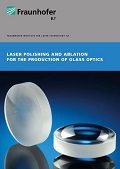Aspheres and free-form optics are increasingly being used in imaging optics as well as in illumination technology. As a result, there is a growing need for flexible and economical production methods for optics with non-spherical surfaces. Fabricating aspheres and free-form optics conventionally is time consuming due to the necessary point or line contact between tool and work-piece and, hence, cost-intensive. The laser ablation and laser polishing of glass developed at the Fraunhofer Institute for Laser Technology ILT offers flexible and cost-effective alternatives to conventional manufacturing processes.
Laser Polishing and Ablation for the Production of Glass Optics
The Process
When glass is processed with CO2 laser radiation, the laser radiation is absorbed in a thin surface layer of the workpiece so that the temperatures can be raised up to the material’s evaporation temperature. If the glass material is heated locally by the interaction with the laser radiation above the evaporation temperature, material can be ablated. This laser-based ablation process can be used for shaping as well as for correction polishing, called Laser Beam Figuring. In laser polishing, the viscosity of the material is reduced as the surface is heated to just below the evaporation temperature so that the roughness flows out and is smoothed due to the surface tension. Compared to that of conventional polishing processes, the innovation of laser polishing lies in its fundamentally different mode of action: It smooths by remelting and relocating instead of ablating material. As a result, the laser polishing achieves, among others, an advantageously smaller micro roughness and avoids subsurface damage. These process steps – laser ablation, laser polishing and Laser Beam Figuring – can be used in a process chain for the fabrication of optics. By appropriately selecting the respective process parameters, a user can adapt the processes to almost any surface form.
Laser Ablation of Glass
Processing glass with laser radiation has a great advantage: It machines without contacting the workpiece. High costs for grinding tools are, therefore, avoided thanks to a virtually wear-free tool during laser ablation. Due to the local ablation, steep flanks can also be generated, in addition to free-form surfaces, to structure the rear side of optics, for example, in order to reduce weight.
Process Characteristics and Advantages
- High flexibility thanks to non-contact processing
- Ablating rate in fused silica up to 3 mm³/s
- Ablation takes place in layers with ablation depths of 0.1 - 10 μm per layer
- No incorporation of abrasives into the surface
Laser Polishing of Glass
In contrast to the conventional polishing of non-spherical surfaces with point or line contacts, the laser-based polishing of glass surfaces takes place without any abrasives. In addition, the machining time of laser polishing is independent of surface shape and shorter than conventional polishing methods by a factor of up to 100. The achievable surface roughness of fused silica in this case is rms < 5 nm (measurement field: 1 × 1 mm2) and the micro roughness rms < 0.4 nm (measurement field: 50 × 70 μm2). In addition to fused silica, almost every fusible glass can be polished with laser radiation. Applications for the laser polishing of glass surfaces include illuminating optics, for which the values obtained so far are already sufficient.
Process Characteristics and Advantages
- High flexibility thanks to non-contact machining
- High process speed independent of the surface geometry (1 - 10 cm²/s)
- Smaller micro roughness compared to conventional polishing
- Selective polishing by local processing
- Healing of subsurface damage
Laser Beam Figuring
At present, laser polishing cannot be used for final polishing of imaging optics since there are residual shape deviations and residual waviness. One possible solution is to expand the method with a downstream laser-based step for shape correction – Laser Beam Figuring. In this processing step, material is locally removed in the smallest amounts at the required points, thereby reducing the ripple of the surface.
Process Characteristics and Advantages
- Ablation depth < 5 nm with a lateral resolution of < 100 μm
- Measurement of the surface before machining is necessary to identify the areas to be removed
- Suitable glass types: fused silica, ULE
 Fraunhofer Institute for Laser Technology ILT
Fraunhofer Institute for Laser Technology ILT